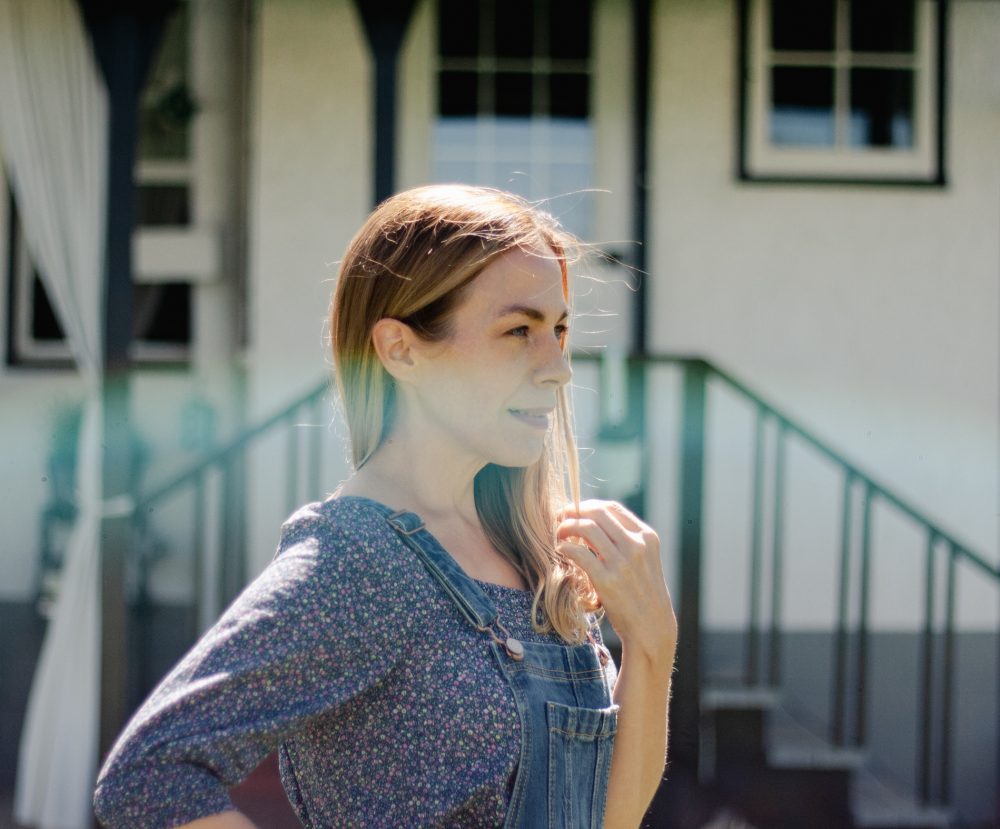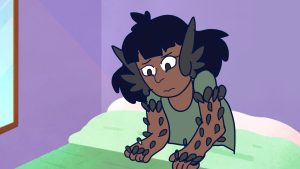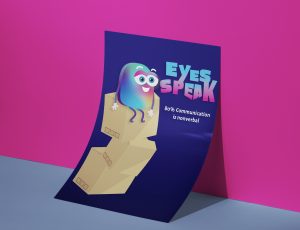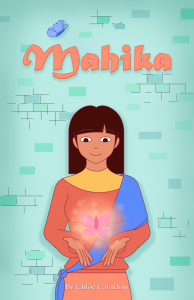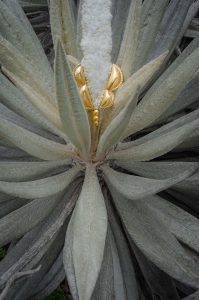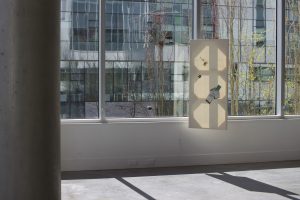- #Biophilic/Biocentric
- #Care
- #Community
- #Contemporary
- #Culture
- #Decolonization
- #Drawing
- #Ecology
- #Emergency
- #Environment
- #Ephemeral
- #Handmade
- #Healing
- #History
- #Home
- #Indigenous
- #Installation
- #Landscape
- #Low Res
- #Material Practice
- #Mixed Media
- #Nature
- #Personal
- #Political
- #Relationships
- #Sculpture
- #Social
- #Storytelling
- #Sustainability
- #Textile
- #Women
- #Wood
Wâhkôhtowin: Gestures in Kinship, Reciprocity & Rematriation
Lara Felsing
ECU Award Recipient
Renée Van Halm + Pietro Widmer Graduation Award for Visual Arts – Winner
(Wâhkôhtowin, Cree, meaning kinship. Referring to the interconnected nature of relationships, communities, and natural systems)
Dion, S. (2020, May 14). Wâhkôhtowin: The Value of Relationships Amid Crisis. The Quad. https://www.ualberta.ca/the-quad/2020/05/wahkohtowin-the-value-of-relationships
I am an interdisciplinary Métis artist from Northern Alberta, Canada. My practice explores the interconnectedness of all life on Earth and aims to bring awareness to the necessity of caring for the Earth and all living beings. My material practice and research are approached with ‘two-eyed seeing’, with one eye looking through a lens of Indigenous teachings and the other through a lens of Western knowledge. Traditional plant harvesting is at the core of my practice, and I collect the likes of roots, leaves, berries, petals, spruce tips and pine needles to create compostable paintings, sculptures and blankets that speak to the necessity to honour and show gratitude for the gifts provided by Mother Earth.
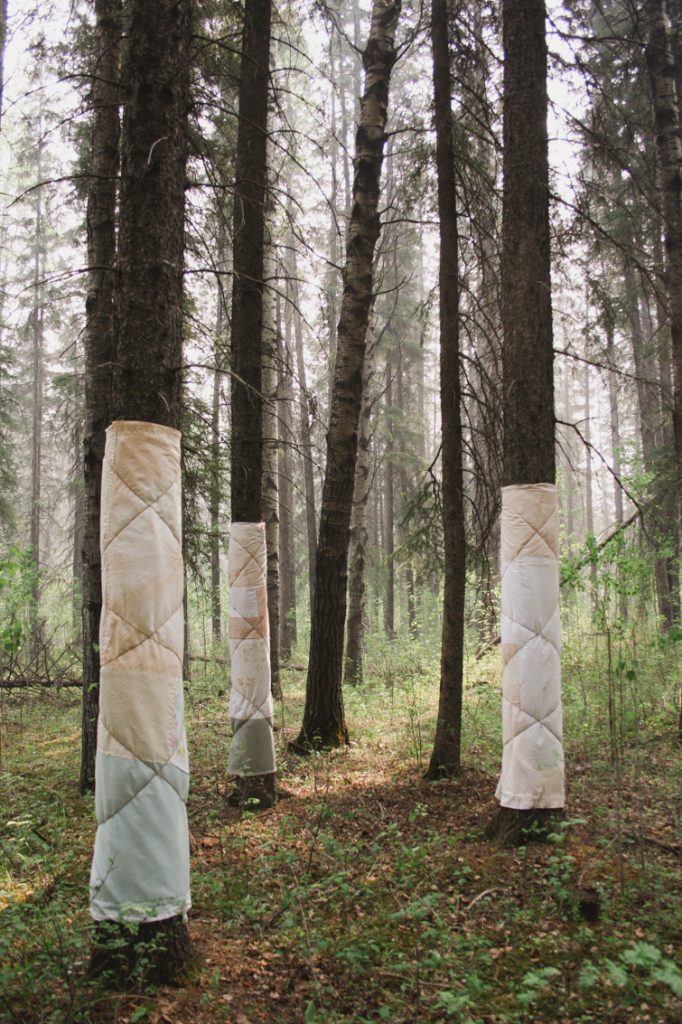
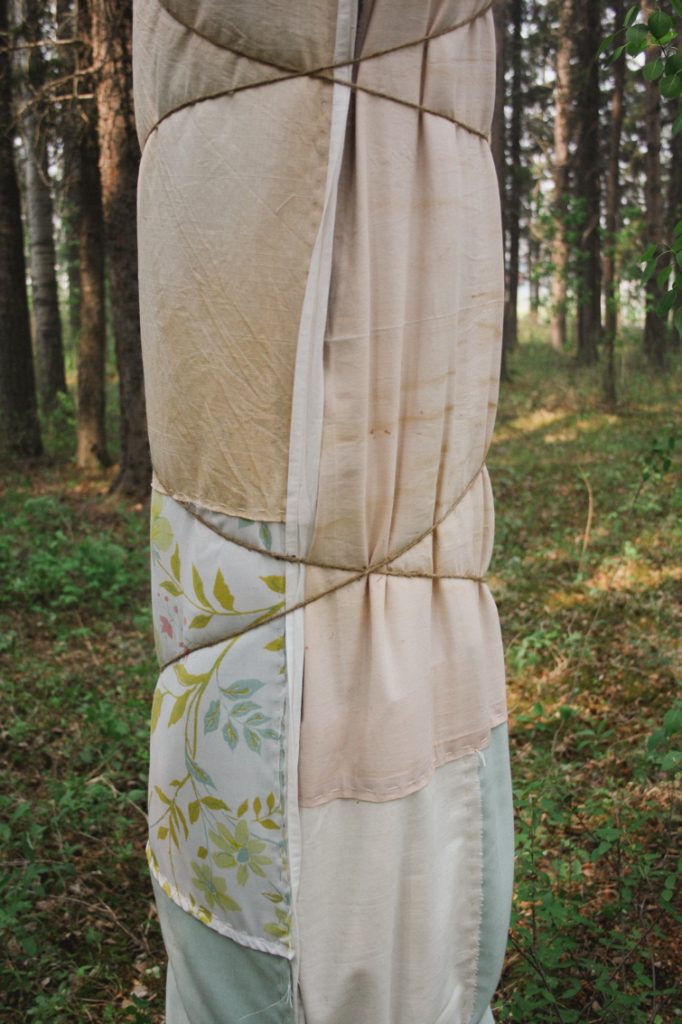
Left: Blanket Ceremony for the Forest. Edson Alberta, May 21, 2023.
Right: Gratitude Blanket, detail. Second-hand cotton thread, linen, canvas and floral broadcloth dyed with spruce cones, Saskatoon berries, Sweetgrass, tobacco, cedar, sage, Chaga, strawberries, dandelion and bee pollen, 2023.
Given the recent unprecedented Alberta wildfires, I wanted to show gratitude for the forest where I live with a blanket ceremony. The blanket ceremony occurred in the forest near my home between wildfire evacuations. The blankets are made from plant pigments I harvested and hand-dyed onto second-hand fabric from the community. They were placed in the forest near my home as a gesture of care and reciprocity.
Each Gratitude Blanket measures approximately 80″ X 65″ and is sewn onto a civil defence blanket from 1952. The civil defence blankets were part of the National Emergency Strategic Stockpile (NESS). They have been held with food, medical supplies, and other resources in the event of a nuclear attack since the early 1950s in Edson, Alberta. The civil defence blankets were wrapped in bundles and stored in burlap sacks in the town’s Post Office basement. Last year they were discovered and are currently being sold as a fundraiser for the Galloway Station Museum.
The civil defence blankets are repurposed for this project as a gesture towards honouring forests and bringing awareness to the importance of more-than-human communities.
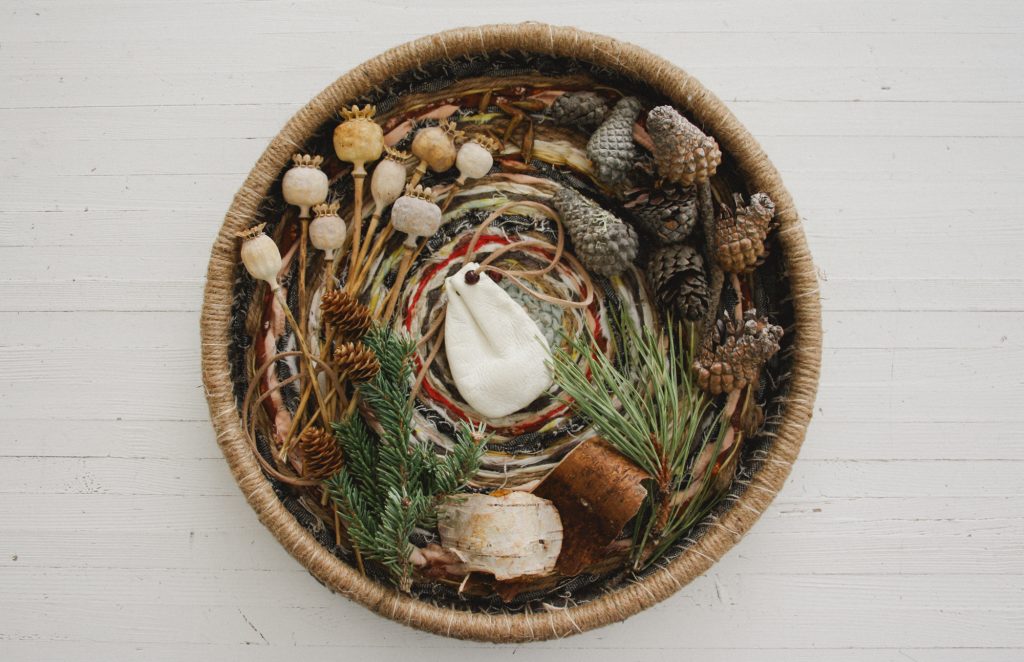
Harvesting Tray with Deerskin Medicine Bag. Second-hand cotton fabric, canvas, floral broadcloth, burlap and cotton thread dyed with Sweetgrass, tobacco, cedar, sage, Chaga, moss, spruce cones and needles, Saskatoon berries, strawberries, dandelion, yarrow, wild mint, bee pollen, shale and charcoal, buffalo wool, wood hoops. 12″ across X 1.5″ deep, 2023.
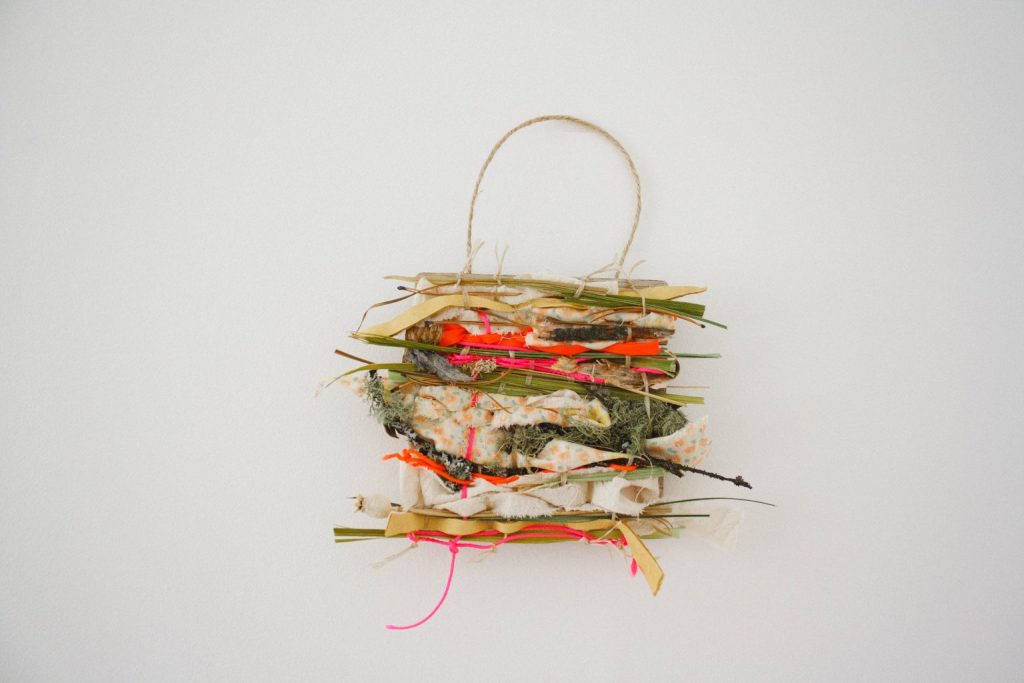
Interwoven (All My Relations). Found wood, second-hand floral broadcloth, string, flagging cord, twine, Sweetgrass, moss, twigs and pine needles and flagging tape from the forest near my home, poppy pods from my garden, remnant pieces of sinew and deer hide . 6″ X 6″, 2021.

Polluted Medicine. Sweetgrass and flagging tape. 36″ X 1″, 2022.


WHAT ABOUT CHARLOTTE? CHARLOTTE SMALL. Hand-dyed second-hand cotton fabric and embroidery thread coloured with Sweetgrass, Chaga and spruce cones and needles, clay, tobacco, strawberries, strawberry leaves, charcoal, dandelions, graphite and vegetable dye printed photograph on wood. 12″ X 12″, 2023. (This diptych was inspired by a conversation I had with a shop owner when I spotted the David Thompson pennant.)
“Standing in the silence, Charlotte Small was an important figure, giving a voice to the many multi-skilled women who were unpaid and nameless in the male dominated fur trade that was highly dependent upon Aboriginal and Métis women acting as guides, translators, confidantes and expert wilderness survivalists. Charlotte Small performed all these roles as a wife, mother and daughter. Her courage and achievements will withstand the test of time and serve as encouragement for the generations of Aboriginal women to come, and recognition of the many silent women of the fur trade.”
– Pat McDonald, historian and author, Rocky Mountain House
(Charlotte Small celebrated as a national historic person. Cision Canada. (2018, December 24).
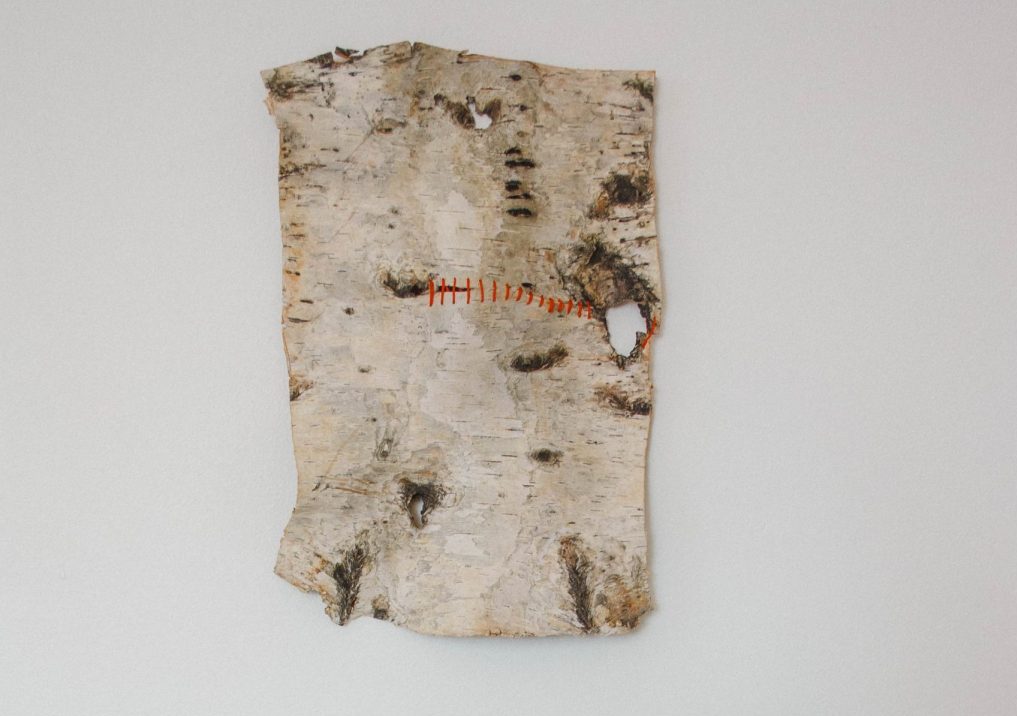
Reclamate. Embroidery thread on birch bark from our woodpile, 2021.
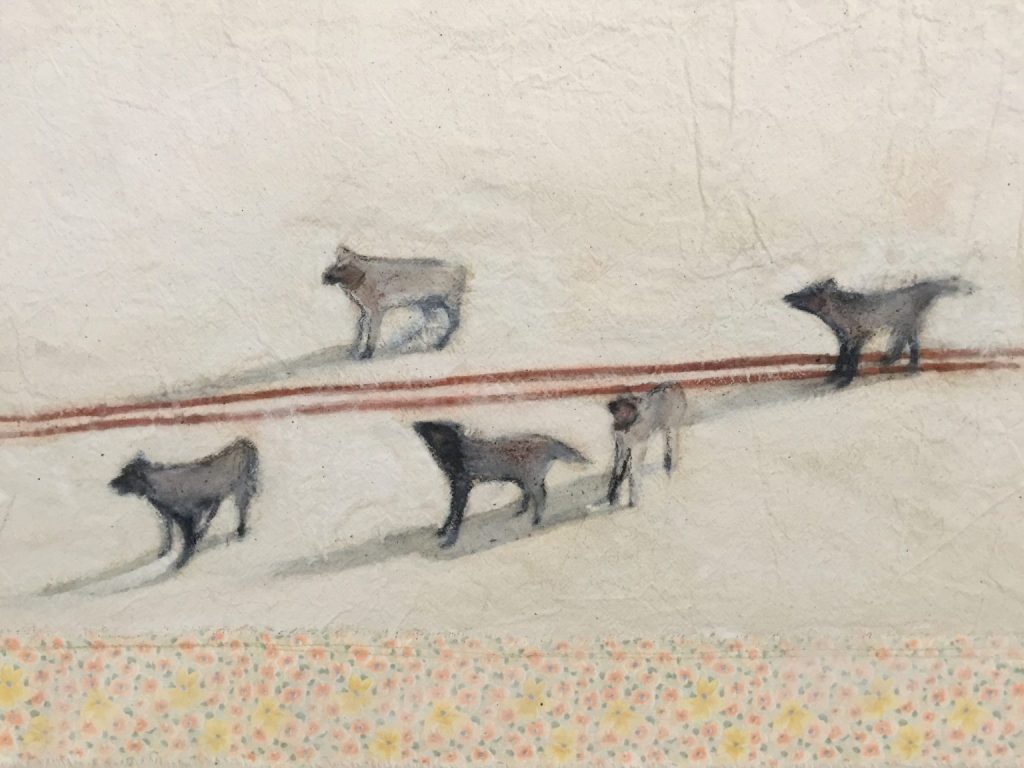
Wolves in the Tonquin Valley. Chaga tea, handmade charcoal stick, strawberries, plant pigments, clay and Saskatoon berries on unbleached cotton. 16″ X 24″, 2022.
The Tonquin Valley is the home to one of Jasper National Park’s last caribou herds. The recreational trails made by humans have created a linear path for wolves to access the herd and easily hunt the caribou. As reported by Joanne McQuarrie, Local Journalism Initiative Reporter for the Jasper Fitzhugh, recreational cross-country ski tracks and footprints made from walking in the snow are creating a network of efficient hunting trails for local wolf packs.
In this painting I have divided the composition into three horizons. The bottom of the painting has a hand-stitched overlay of floral broadcloth, which was a popular trade item between the Hudson’s Bay Trading post and Indigenous communities. Floral broadcloth is still used today to make ribbon shirts and skirts. In this painting, it represents Indigenous values regarding the land and animals and a connection to past ways of coexisting with other species. The middle section of this painting depicts recreational cross-country ski tracks rendered a deep orange colour with berries and tea. This is how I feel a wolf pack would perceive ski tracks imprinted in the snow. Wolves create their own linear trail systems throughout the forest for efficient travel. The top section of the painting is left as blank snow, acting as a prediction of the cost to these species when human interactions affect their natural way of existing.
McQuarrie, J. (2021, February 10). Backcountry skiers urged to stay out of Tonquin Valley to protect caribou. Jasper Fitzhugh.
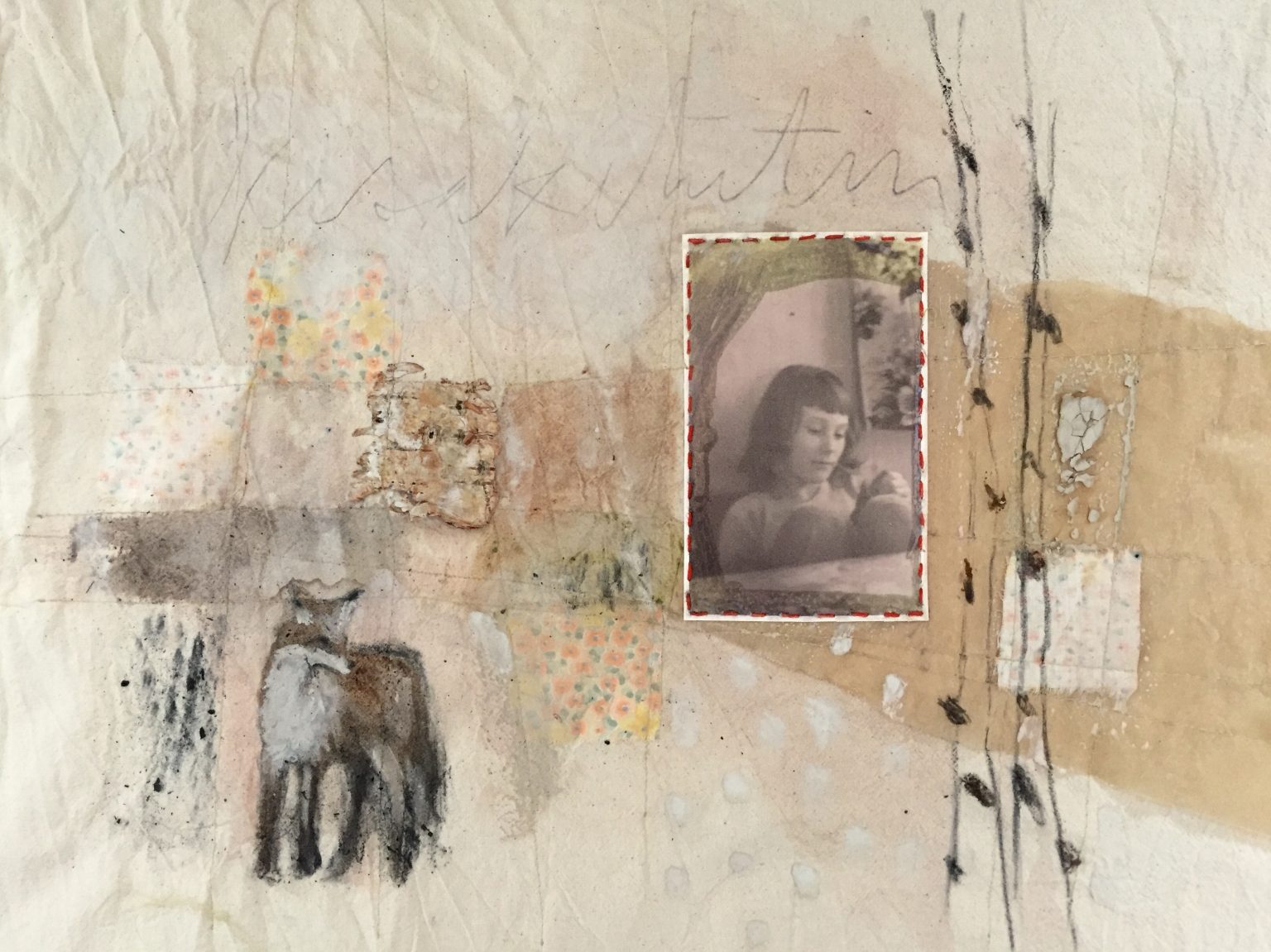
Keeper of the Fire. Second-hand Floral Broadcloth, Cotton thread, Vegetable ink photo print on paper, embroidery thread, handmade charcoal, clay, soil, Saskatoon berries and birch bark from my yard, locally harvested Chaga tea and Sweetgrass on cotton, 2022.
I consider my mother to be the Keeper of the Fire in our family. Her connection to her Indigenous roots and determination to pass on traditions to the next generations has kept our family connected to our Métis heritage. She is the last of three generations of residential school survivors in our family. Stitched into the painting is a photograph of my mother as a child. She is at her Grandmother’s house, cutting out paper valentines. My mother’s house burned down when she was young, and this is one of the few photos of her remaining.
I stitched the print on unbleached cotton with embroidery thread and added layers of Chaga tea, Saskatoon berry juice, clay, soil, dried Sweetgrass and squares of floral broadcloth. My mother was raised in a small farming village, and I wanted to depict the land as an aerial view of farmland stitched with squares of fabric patches like a patchwork quilt. Patchwork has always been a common theme in my work and references the blankets made from remnant fabric that covered our beds when I was little. I continued the tradition when my children were born. Foxes have special significance in Métis culture as they are intelligent and resourceful. In addition, Fox Woman is a Cree animal spirit portrayed as a wise Elder. (She guides a boy she adopts as her grandson through many travails.) I see the same characteristics in my mother, who is always available to support the younger generations in our family with her knowledge and reverence.
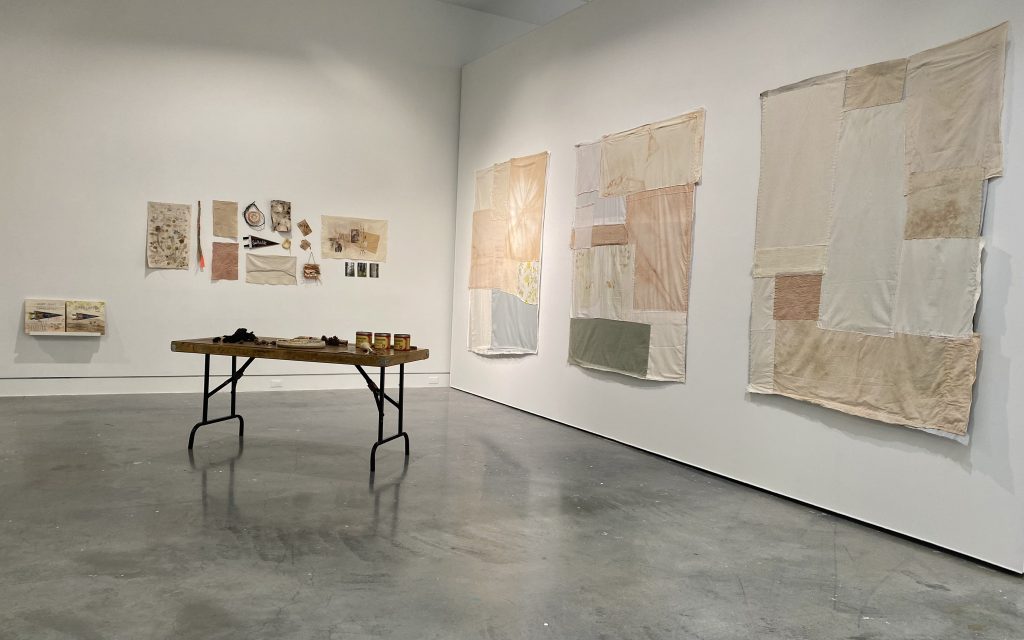
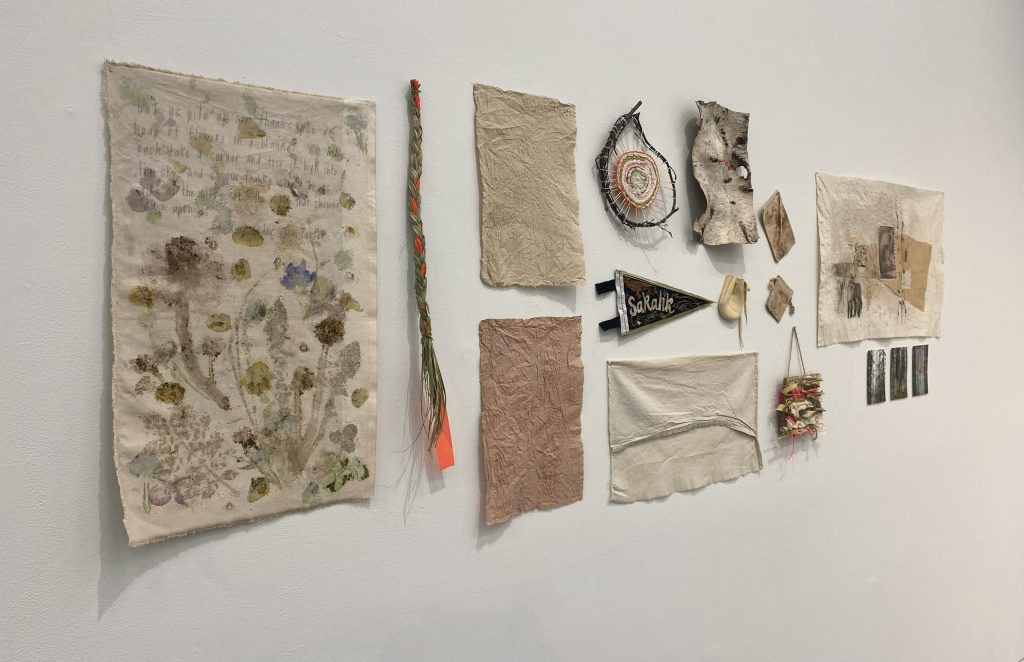
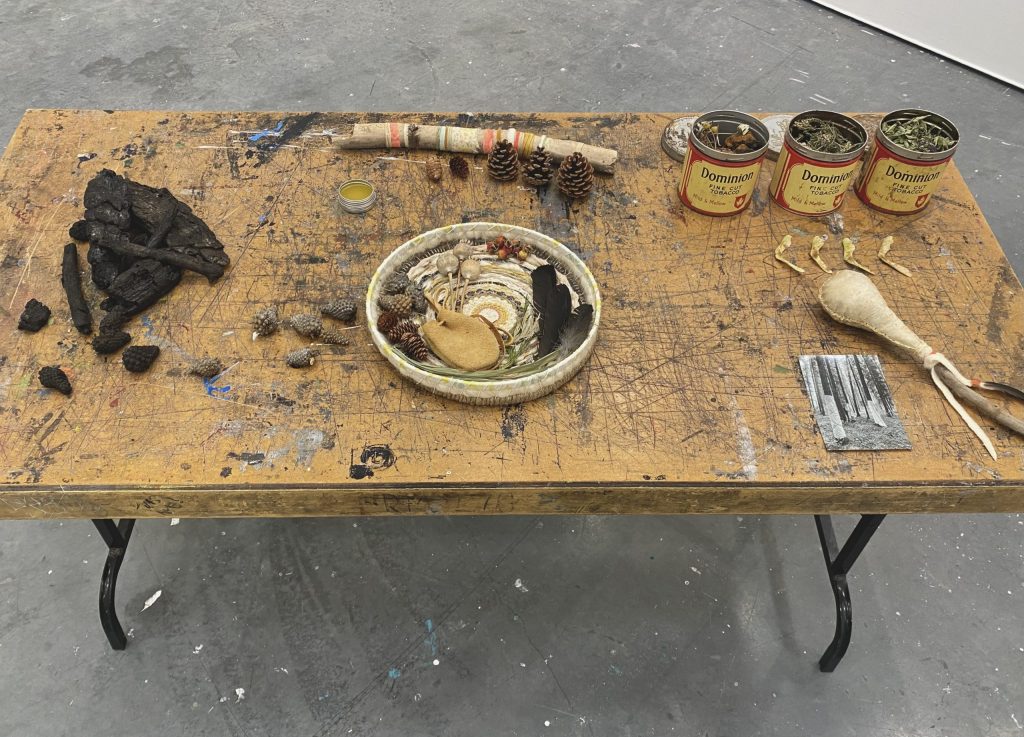
Left image: MFA Thesis Installation: Wâhkôhtowin: Gestures in Kinship, Reciprocity & Rematriation.
“Let us pile up our thanks like a heap of flowers on a blanket. We will each take a corner and toss it high into the sky. And so our thanks should be as rich as the gifts of the world that shower down upon us.”
– Mohawk Elder Tom Porter
Kimmerer, R. W. (2020). Braiding Sweetgrass: Indigenous Wisdom, scientific knowledge and the teachings of plants. Milkweed Editions. (Pg. 114-115)
Center image: Quote by Tom Porter. Second-hand cotton dyed with black spruce cones, dandelions, strawberry leaves, poppies, bluebells, Sweetgrass and Fireweed harvested from my garden and the forest near my home, 2023.
Polluted Medicine. Sweetgrass and flagging tape, 2022.
Plant-dyed Fabric. Second-hand cotton fabric dyed with black spruce, tobacco and cedar, 2023.
Tree Timeline (Flagging and Removal). Found birch branch, cotton embroidery thread, flagging cord, second-hand wool, twine, sinew and floral broadcloth, 2021.
Sakahk Pennant (Cree, meaning forest). Second-hand wool and cotton thread, floral broadcloth, pine needles, leaf, moss, twig and dried dandelions, 2021.
Reclamate. Embroidery thread on birch bark, 2021.
Medicine Bags. Sage and spruce-dyed second-hand cotton bags, flower petals, deer hide, cotton thread, 2022.
Interwoven (We are all Related), Found wood, second-hand floral broadcloth, string, flagging cord, twine, Sweetgrass, moss, twigs and pine needles and flagging tape from the forest near my home, poppy pods from my garden, remnant pieces of sinew and deer hide . 6″ X 6″, 2021.
Keeper of the Fire. Second-hand floral broadcloth, cotton thread, vegetable ink photo print on paper, embroidery thread, handmade charcoal, clay, soil, Saskatoon berries and birch bark from my yard, locally harvested Chaga tea and dried Sweetgrass on cotton, 2022.
A Blanket Ceremony for the Forest. Photographs, 2023.
Right image: (left to right) Wood and Lodgepole pine cones from Alberta Wildfire EWF-031, 2023.
For the past two months, multiple wildfires have spread across Alberta. As a result, approximately 30,000 people, including my family, have been evacuated from their homes. This year’s wildfires in our area are unprecedented and historically have not been recorded to this magnitude. The charred black spruce and Lodgepole pine wood and cones were gathered 1.5 km south of my home in Edson, Alberta.
Poplar Bud & Juniper Salve. Poplar buds, juniper berries, beeswax, olive oil, 2022. (Made from poplar buds and juniper berries I harvested in the forest near my home)
Adorned in Gratitude. Found driftwood, floral broadcloth, Sweetgrass, remnants of deer hide, sinew, wool, sage-dyed second-hand cotton and feathers, 2022.
Harvesting Tray. Second-hand cotton fabric, floral broadcloth, burlap and cotton thread dyed with Sweetgrass, tobacco, cedar, sage, Chaga, moss, spruce cones and needles, Saskatoon berries, strawberry runners, dandelion, yarrow, mint, bee pollen, shale and charcoal, Buffalo wool, wood, 2023. (The Harvesting Tray was made with remnant fabric from the Gratitude Blankets and holds a Medicine Bag I made with locally harvested and tanned moose hide, lodgepole pine cones, poppy pods, crow feathers, cedar, rose hips, spruce cones, and switchgrass.)
For Adeline. Dominion Tobacco tins filled with Chaga and daisies, yarrow, and mint, 2023.
In honour of my Woodland Cree Grandmother, Adeline, I keep the medicinal plants I harvest and dry in Dominion Tobacco tins. She smoked Dominion Tobacco and filled the empty tins with plant medicines she carefully gathered throughout the year.
Rattle. Elk hide, seashells gifted from Thea Canlas, seed beads, wool Hudson’s Bay blanket, floral broadcloth, sinew, Sweetgrass-dyed second-hand lace, remnant cotton embroidery thread, rose hip, found magpie feather and driftwood, 2022.
A Blanket Ceremony for the Forest, 2023. Photograph by Stefan Felsing
